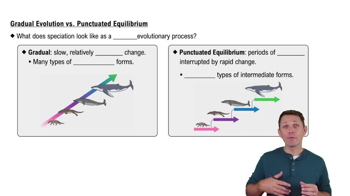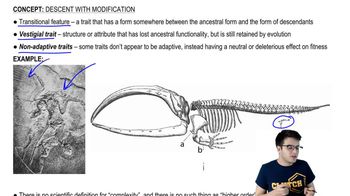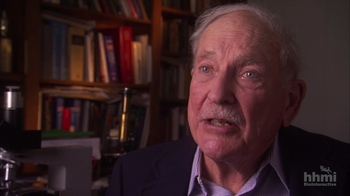Table of contents
- 1. Introduction to Biology2h 42m
- 2. Chemistry3h 40m
- 3. Water1h 26m
- 4. Biomolecules2h 23m
- 5. Cell Components2h 26m
- 6. The Membrane2h 31m
- 7. Energy and Metabolism2h 0m
- 8. Respiration2h 40m
- 9. Photosynthesis2h 49m
- 10. Cell Signaling59m
- 11. Cell Division2h 47m
- 12. Meiosis2h 0m
- 13. Mendelian Genetics4h 44m
- Introduction to Mendel's Experiments7m
- Genotype vs. Phenotype17m
- Punnett Squares13m
- Mendel's Experiments26m
- Mendel's Laws18m
- Monohybrid Crosses19m
- Test Crosses14m
- Dihybrid Crosses20m
- Punnett Square Probability26m
- Incomplete Dominance vs. Codominance20m
- Epistasis7m
- Non-Mendelian Genetics12m
- Pedigrees6m
- Autosomal Inheritance21m
- Sex-Linked Inheritance43m
- X-Inactivation9m
- 14. DNA Synthesis2h 27m
- 15. Gene Expression3h 20m
- 16. Regulation of Expression3h 31m
- Introduction to Regulation of Gene Expression13m
- Prokaryotic Gene Regulation via Operons27m
- The Lac Operon21m
- Glucose's Impact on Lac Operon25m
- The Trp Operon20m
- Review of the Lac Operon & Trp Operon11m
- Introduction to Eukaryotic Gene Regulation9m
- Eukaryotic Chromatin Modifications16m
- Eukaryotic Transcriptional Control22m
- Eukaryotic Post-Transcriptional Regulation28m
- Eukaryotic Post-Translational Regulation13m
- 17. Viruses37m
- 18. Biotechnology2h 58m
- 19. Genomics17m
- 20. Development1h 5m
- 21. Evolution3h 1m
- 22. Evolution of Populations3h 52m
- 23. Speciation1h 37m
- 24. History of Life on Earth2h 6m
- 25. Phylogeny2h 31m
- 26. Prokaryotes4h 59m
- 27. Protists1h 12m
- 28. Plants1h 22m
- 29. Fungi36m
- 30. Overview of Animals34m
- 31. Invertebrates1h 2m
- 32. Vertebrates50m
- 33. Plant Anatomy1h 3m
- 34. Vascular Plant Transport1h 2m
- 35. Soil37m
- 36. Plant Reproduction47m
- 37. Plant Sensation and Response1h 9m
- 38. Animal Form and Function1h 19m
- 39. Digestive System1h 10m
- 40. Circulatory System1h 57m
- 41. Immune System1h 12m
- 42. Osmoregulation and Excretion50m
- 43. Endocrine System1h 4m
- 44. Animal Reproduction1h 2m
- 45. Nervous System1h 55m
- 46. Sensory Systems46m
- 47. Muscle Systems23m
- 48. Ecology3h 11m
- Introduction to Ecology20m
- Biogeography14m
- Earth's Climate Patterns50m
- Introduction to Terrestrial Biomes10m
- Terrestrial Biomes: Near Equator13m
- Terrestrial Biomes: Temperate Regions10m
- Terrestrial Biomes: Northern Regions15m
- Introduction to Aquatic Biomes27m
- Freshwater Aquatic Biomes14m
- Marine Aquatic Biomes13m
- 49. Animal Behavior28m
- 50. Population Ecology3h 41m
- Introduction to Population Ecology28m
- Population Sampling Methods23m
- Life History12m
- Population Demography17m
- Factors Limiting Population Growth14m
- Introduction to Population Growth Models22m
- Linear Population Growth6m
- Exponential Population Growth29m
- Logistic Population Growth32m
- r/K Selection10m
- The Human Population22m
- 51. Community Ecology2h 46m
- Introduction to Community Ecology2m
- Introduction to Community Interactions9m
- Community Interactions: Competition (-/-)38m
- Community Interactions: Exploitation (+/-)23m
- Community Interactions: Mutualism (+/+) & Commensalism (+/0)9m
- Community Structure35m
- Community Dynamics26m
- Geographic Impact on Communities21m
- 52. Ecosystems2h 36m
- 53. Conservation Biology24m
21. Evolution
Introduction to Evolution and Natural Selection
Problem 7`
Textbook Question
A swim bladder is a gas-filled sac that helps fish maintain buoyancy. Evidence indicates that early fish gulped air into primitive lungs, helping them survive in stagnant waters. The evolution of the swim bladder from lungs of an ancestral fish is an example of a. an evolutionary trend. b. paedomorphosis. c. the gradual refinement of a structure with the same function. d. exaptation.
 Verified step by step guidance
Verified step by step guidance1
Understand the concept of exaptation: Exaptation refers to a trait that evolves for one function but is later co-opted for a different function. In this case, the lungs of ancestral fish evolved to help them survive in stagnant waters but were later adapted into swim bladders for buoyancy.
Analyze the evolutionary process described: The problem mentions that the swim bladder evolved from lungs, which indicates a change in function over time. This aligns with the concept of exaptation.
Compare the other options: a) An evolutionary trend refers to a general direction of change in traits over time, which is not specific to the functional shift described here. b) Paedomorphosis refers to the retention of juvenile traits in adult organisms, which is unrelated to the transformation of lungs into swim bladders. c) Gradual refinement of a structure with the same function does not apply because the function changed from respiration to buoyancy.
Focus on the correct answer: The transformation of lungs into swim bladders represents a shift in function, which is characteristic of exaptation.
Conclude that the correct answer is d. exaptation, based on the evidence provided and the definition of the term.
 Verified video answer for a similar problem:
Verified video answer for a similar problem:This video solution was recommended by our tutors as helpful for the problem above
Video duration:
47sPlay a video:
Was this helpful?
Key Concepts
Here are the essential concepts you must grasp in order to answer the question correctly.
Evolutionary Trend
An evolutionary trend refers to a general direction in which a species or group of organisms evolves over time, often leading to increased complexity or adaptation to specific environments. In the context of the swim bladder, it highlights how certain traits can become more pronounced or refined as species adapt to their ecological niches.
Recommended video:

History of Evolutionary Theory Example 1
Exaptation
Exaptation is a process in evolution where a trait that originally evolved for one function is co-opted for a different purpose. The swim bladder's evolution from primitive lungs exemplifies exaptation, as the original function of gas exchange in lungs was repurposed to aid in buoyancy control in aquatic environments.
Recommended video:

Origin of Complex Traits
Gradual Refinement
Gradual refinement refers to the slow and continuous process of change in a biological structure or function over generations. This concept is crucial in understanding how the swim bladder evolved from lungs, as it illustrates how small, incremental changes can lead to significant adaptations that enhance survival in specific habitats.
Recommended video:

Gradual Evolution vs. Punctuated Equilibrium

 4:58m
4:58mWatch next
Master Evolution and Natural Selection with a bite sized video explanation from Jason
Start learningRelated Videos
Related Practice
































